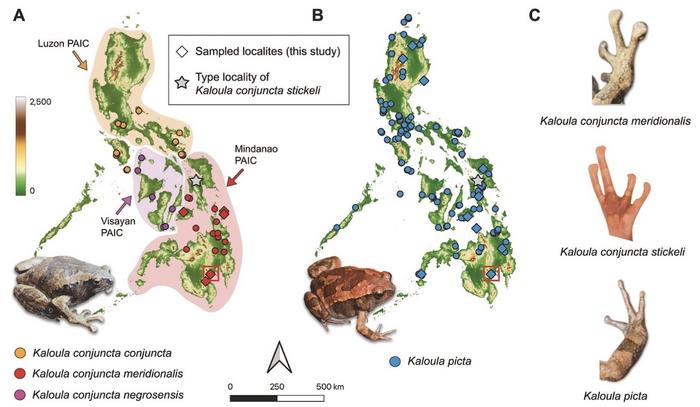In recent studies conducted by evolutionary biologists from the University of Kansas, a long-standing mystery surrounding the Leyte Chorus Frog, an elusive amphibian endemic to the Philippines, has finally been unraveled. This tiny frog, known scientifically as Kaloula conjuncta stickeli, manages to elude not only skilled researchers but also the very frameworks of species classification that have persisted for decades. The intrigue surrounding this species stems from its unique physical characteristics, particularly its unusual toe discs, which have puzzled scientists since its initial discovery in the mid-20th century.
The Leyte Chorus Frog was first collected in 1944, its description emerging in the biological literature in 1954. In that time, it garnered attention for its distinct morphology. However, years of intensive searches by herpetologists and biologists yielded only a handful of additional specimens, leading to growing doubts about the frog’s classification as merely a subspecies of a greater complex of frogs. This rarity not only complicated the classification but also sparked fears that the species might already be extinct, hidden away within the fragmented remains of its native forest habitat.
Deforestation has played a significant role in shaping the habitats of many species across the Philippines, a nation comprised of thousands of islands that historically boasted rich and diverse ecosystems. The destruction of its lush forests has led to severe fragmentation of wildlife populations. The Leyte Chorus Frog’s peculiarities are believed to be a direct result of habitat disruption. With altered environments, the behavioral and ecological interactions among amphibian species, including Kaloula conjuncta stickeli, have become much more complex and multifaceted.
The recent research investigated the genetic lineage of the Leyte Chorus Frog and sought to clarify its ambiguous taxonomic status. Through innovative genomic analysis, researchers were able to categorize this frog not simply as a subspecies but as a distinctive result of hybridization between two species with overlapping territories. These findings challenge previous concepts of this amphibian’s classification, suggesting that it is a product of hybridization induced by the very conditions that threaten its survival. Such insights exemplify how environmental factors can directly influence evolutionary trajectories among once-isolated populations.
In this study, researchers utilized biological specimens collected over decades, tapping into a historical record of biological diversity stored within museum collections. The sampling included both the original specimens from 1944 and those collected from Mindanao Island in 1996, which provided crucial comparisons to glean insights from the species’ genetic makeup. This method of employing preserved specimens allowed the research team to navigate through the long-standing questions surrounding the frog’s origins, making it evident that powerful tools are necessary for tackling such taxonomic enigmas.
By utilizing cutting-edge genetic sequencing technologies alongside bioinformatics tools, researchers established that the Leyte Chorus Frog is an F1 hybrid, resulting from a cross between Kaloula conjuncta meridionalis and Kaloula picta. This newfound understanding reveals that ecological changes due to deforestation enabled these two species, which traditionally occupy different niches—one residing in trees and the other on the ground—to come into contact and breed. Their hybrid offspring showcase a blend of traits from their parent species, further complicating issues of classification in biological taxonomy.
The hybrid complexity of the Leyte Chorus Frog poses intriguing questions about its reproduction and survival. Notably, researchers suspect that genetic incompatibilities likely arise during breeding attempts between hybrid individuals, leading to a reproductive dead end. Chan Kin Onn, the paper’s lead author, emphasizes that while these frogs exhibit hybrid vigor, their inability to produce viable, fertile offspring renders them a dead-end branch in the evolutionary tree. This revelation raises concerns about the long-term prospects of the hybrid frog, as well as its consequent implications for conservation efforts aimed at preserving the genetic integrity of its parent species.
The role of natural history museums and accessioned specimens in this research cannot be overstated. These collections serve as essential repositories of biodiversity information that transcend time, allowing researchers to revisit specimens and question long-held beliefs about the relationships between species. The meticulous documentation of each specimen, including the ecological context of their discovery, provides invaluable insights necessary for fields like evolutionary biology, emphasizing the importance of historical collections in contemporary research endeavors.
As scientists turn their attention toward the future of these amphibians, a renewed focus on habitat conservation and the restoration of fragmented ecosystems has become paramount. The story of the Leyte Chorus Frog highlights the need to understand how anthropogenic influences such as habitat destruction can alter genetic trajectories and lead to unforeseen evolutionary outcomes. This not only aids in the study of specific species but also illuminates broader principles of biodiversity and evolutionary processes.
There exists a delicate balance between the pressures of environmental factors and the adaptive responses of species. The Leyte Chorus Frog serves as a reminder of the complex interplay between biology and ecology, as well as a cautionary tale about the consequences of habitat loss. As researchers like Chan continue to explore the depths of biodiversity, investigating such hybrid phenomena will be increasingly important in safeguarding the future of the natural world.
The findings from this research are set to invoke further investigation into the evolutionary mechanisms that fuel hybridization and speciation under changing environmental conditions, adding to our understanding of amphibian diversity while also stressing the urgency for conservation strategies.
In conclusion, the Leyte Chorus Frog proves to be much more than a peculiar amphibian—the study of its evolutionary lineage reveals intricate connections between species driven by environmental change. Thus, the research not only clarifies the status and fate of a long-misunderstood creature but also enriches our understanding of the broader ecological networks that underpin species survival in an increasingly fragmented world.
Subject of Research: Leyte Chorus Frog, Hybridization, Evolutionary Biology
Article Title: Unveiling the Mystery of the Leyte Chorus Frog: A Hybridization Saga
News Publication Date: October 2023
Web References: Journal
References: Chan et al., Heredity
Image Credits: Chan et al.
Keywords: Leyte Chorus Frog, Kaloula conjuncta stickeli, Hybridization, Evolution, Conservation, Amphibians, Biodiversity, Genetic Analysis




